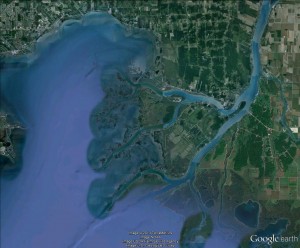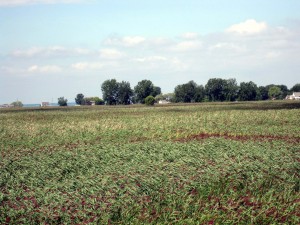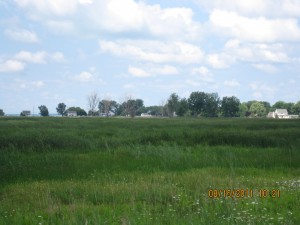Jason Hill of Ducks Unlimited shares information about the Anchor Bay & St. Clair Flats Phragmites Control and Education Project.
What is the geographic scope of the project?
Over 1,200 acres along Lake St. Clair in St. Clair County, Michigan; including St. Clair Flats Wildlife Area, Dickinson Island and surrounding Anchor Bay
What type of land does your project target?
Coastal wetlands
What type of project is this?
- Education and outreach
- Direct management
Why is Phragmites an issue in your area?
The spread of highly invasive Phragmites (Phragmites australis) is a recent and major factor in the degradation of Lake St. Clair’s coastal wetlands. The recent decrease in Great Lakes water levels has lead to the expansion of emergent vegetation in the littoral zone of Lake St. Clair; however, lower water levels have also facilitated the rapid expansion of Phragmites. In many areas of Lake St. Clair, Phragmites is expanding at a much faster rate than native emergent plants. With its strong capacity to spread by rhizomes, near-monotypic stands of invasive Phragmites have replaced high quality, complex communities of native plants, leading to loss of fish and wildlife habitat, biodiversity, and a native plant community resiliency. In addition to impacts on the area’s natural resources, the residents of Lake St. Clair have also observed ecological, economic and social impacts as a result of the Phragmites invasion.
What is your organization’s approach to invasive Phragmites management?
Ducks Unlimited (DU) along with project partners approached this project through 3 primary components: 1) an integrated management effort to control Phragmites on both public and private coastal wetlands through aerial and ground herbicide treatments, followed by mowing, burning and spot herbicide treatments, 2) monitoring the response of native vegetation and avifauna to these enhancement efforts, and 3) implementation of a public education and outreach program to inform citizens about the impacts and effective management of Phragmites.
Who are your partners in this effort?
- Michigan Department of Natural Resources
- Michigan Sea Grant
- Michigan State University Extension
- Wildlife and Wetland Solutions
- Southeastern Michigan Council of Governments
- Clay Township
- Ira Township
- U.S. Army Corps of Engineers
What are the funding sources?
The U.S. EPA Great Lakes Restoration Initiative.
What are the goals and objectives for the project?
Goal: The goal of this project is to implement on-the-ground Phragmites control activities to restore native wetland plant communities in 1,200 acres of Great Lakes coastal wetlands associated with Lake St. Clair, including the coastal shoreline of Anchor Bay, the St. Clair Flats and Dickinson Island.
Objectives:
- Herbicide will be applied to approximately 1,000 acres of Phragmites infested coastal wetlands on state-owned bottomlands in the St. Clair Flats Wildlife Area and on Dickinson Island. Another 200 acres of degraded coastal wetlands will be treated in nearby coastal communities and inlets of Anchor Bay. Control efforts will be administered by DU. Initial treatments will consist of helicopter and ground-based application of herbicide by licensed applicators. Follow-up treatments will consist of spot herbicide treatment, prescribed burns, or mowing.
- Monitoring treatment success and the re-establishment of native wetland vegetation. A monitoring protocol will be established by DU scientists. Monitoring of plant species diversity and abundance will be used to determine the success of particular treatment methodology as well as provide insight as to where further treatments may be needed.
- DU will partner with the Michigan Sea Grant College Program to implement an education and outreach plan that will deliver information about Phragmites control and activities for involving the public. These activities are to include:
-
- Launching of an outreach campaign focused on activities that riparian property owners and other residents of the Lake St. Clair watershed can do to control the spread of Phragmites;
- Implementation of a teacher professional development workshop in partnership with Macomb and St. Clair County Intermediate School Districts;
- Dissemination of project information to local, state and federal stakeholders via The Macomb/St. Clair Inter-County Watershed Management Advisory Group and St. Clair River Binational Public Advisory Council (BPAC);
- “Phragmites control” information placed on Michigan Sea Grant social networking sites; and
- Signs placed along treatment areas informing the public of the activities being performed
Do you monitor the areas that you manage? If so, what does that entail?
The monitoring aspect of the project consists of visiting the same thirty pre-determined sample sites twice per field season. In the spring, point counts are conducted to survey avifauna. In the fall, vegetation is sampled and avifauna observations are noted.
Sampling plot locations were established in Arc Map using Hawth’s Tools to randomly generate 150 points within pre-determined treatment area polygons, totaling 1200 acres. Of those 150 points only 30 were chosen to be sampling sites. These 30 sample sites were selected based on accessibility, private land access, and timing efficiency. Five sites are inland on Harsen’s Island and twenty-five are along coastal shorelines.
Spring point count survey protocol was adapted from that which is used by Michigan Natural Features Inventory. In the fall, a simple five minute observational bird survey is conducted prior to the vegetation sampling. Four vegetation samples are then taken; one sample in each cardinal direction, 5 meters from the site’s center point, using a 1×1 meter square quadrat. Within each quadrat the following data is collected: percent cover of living Phragmites, percent cover of non-Phragmites vegetation, and percent cover of dead Phragmites. All percentages are expressed as a cover class (classes are shown in the table below). In addition to the quadrat data, 1 photo is also taken in each cardinal direction while standing at the site’s center point.
What is the status of the program and are you seeing results?
Management:
- In 2011 six focus areas within the St. Clair Flats Wildlife Area were identified and delineated and two additional focus areas were added on private lands in 2012. Of the 90 landowners contacted within the focus areas, a total of 50 landowners have signed ten year contracts with DU to have Phragmites treated on their property.
- Our first two herbicide treatments were completed in September of 2011 and September 2012. A total of 1000 acres of public lands and 215 acres of private lands have been chemically treated within the eight focus areas. Patches of Phragmites on private lands ranged from as small as .01 acres to 24 acres.
- Mowing was conducted during the winter/ spring of 2013. A total of 338 acres of herbicide treated (dead) stands of Phragmites were mowed on private lands.
Monitoring:
- Our first two seasons of monitoring will be completed in early June 2013.
Outreach and education:
- Over 290 copies of “A Guide to the Control and Management of Invasive Phragmites” have been distributed at venues including the Lake St. Clair Binational Biennial Conference, Lake St. Clair Metropark, and to to private landowners/project cooperators.
- Presented education and outreach materials developed through the project at the Lake St. Clair Binational Biennial Conference.
- Ongoing social media outreach has been implemented via Sea Grant and Michigan State University Extension.
- Development of signage to post in the treatment areas is in progress
Going forward:
- Monitoring will continue with a spring bird survey in early June 2013 and vegetation sampling and bird surveying in Fall 2013. Education and outreach will continue. Additionally, a request was recently submitted for a one year extension on the project – to include post monitoring and continued outreach.
- Our third and final year of management work will entail spot treatments and potentially spraying buffer areas around existing treatments to prevent future encroachment of herbicide in the fall of 2013. Prescribed burning on DNR owned lands is tentatively scheduled for the winter of 2014.
Can you share information about challenges and lessons learned?
One of the challenges encountered with this project was obtaining agreements and participation from enough private landowners. To successfully eliminate Phragmites from an area, a great deal of coordination and must take place between all landowners. Even if Phragmites is treated on 100 acres owned by a single landowner, the 10 landowners adjoining the treated area will remain a source population if left untreated even if their properties collectively contain less than an acre of Phragmites. Of course gaining 100% buy-in from all landowners is idealistic, but efforts to recruit landowners whose property adjoins treated areas should be a priority. A well-designed outreach strategy implemented prior to any on-the-ground work will aid in recruiting these landowners.
In the St. Clair Flats region, we were fortunate enough to be working in an area with a pre-existing, quasi-grassroots led approach to Phragmites control. The Clay Township Phragmites Advisory Board has been active in the area for some time, educating landowners, providing technical assistance, and making the treatment of “backyard” areas feasible for private landowners. This history paid considerable dividends once our grant was awarded and funds became available to treat Phragmites at no cost to private landowners. Without this, our success in working with private landowners would have been far less.
Although we were successful in treating over 200 acres of Phragmites on properties owned by more than 40 private landowners, other landowners who chose not to participate were hesitant to enter into a formal agreement with DU. In our agreements, we offered to cover 100% of the treatment costs during the first 3 years of the agreement when Phragmites would be reduced to a maintainable level. We asked in return that they maintain the property Phragmites-free for the final 7 years of the 10-year agreement to provide long-term benefits to the ecosystem. Our standard agreements were seemingly straightforward, but admittedly contained agreement jargon and were probably not appropriate for atypical partners such as private landowners (i.e., as opposed to DU’s typical types of partners from state or federal agencies). Other groups implementing invasive treatment projects with similar approaches have had success with shorter term and simplified agreements. Our project would have most likely benefited from simpler, shorter agreements, too, increasing private landowner buy-in and reducing the reestablishment of Phragmites from properties surrounding our core areas of treatments. In either case, an agreement of some sort will be necessary to flow down grant requirements from conservation groups who receive federal funding to do this type of work.
Another challenge encountered was the winter weather conditions and its effect on the mowing schedule. Mowing sites must be completely frozen or completely thawed to allow for proper winter mowing operation. If an incomplete freeze occurs, mowing will be delayed. This challenge would be an important factor to consider when developing mowing contracts in the future
For more information contact,
Jason Hill
Ducks Unlimited – Great Lakes/ Atlantic Regional Office
1220 Eisenhower Pl.
Ann Arbor, MI 48108
United States
jhill@ducks.org
(734)623-2000



